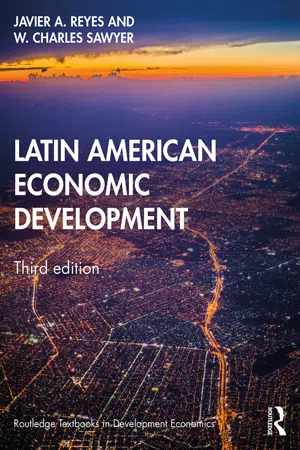
- 338 pages
- English
- ePUB (mobile friendly)
- Available on iOS & Android
Latin American Economic Development
About this book
Latin America is one of the most intriguing parts of the world. The region's illustrious history, culture, and geography are famous internationally, but in terms of economics, Latin America has been generally associated with problems. For many, the combination of a resource-rich region and poor economic conditions has been a puzzle.
This extensively revised and updated third edition of Latin American Economic Development continues to provide the most up-to-date exploration of why the continent can be considered to have underperformed, how the various Latin American economies function, and the future prospects for the region. The book addresses the economic problems of Latin America theme by theme.
Changes and new features in this new edition include:
-
- a new chapter on economic growth that reflects the new understanding of slow growth in the region;
-
- two new appendices on basic microeconomics and macroeconomics;
-
- expanded coverage on new commodities such as lithium and quinoa;
-
- a number of new boxes and updates to existing boxes;
-
- for instructors, PowerPoint presentations and an extensive test bank are available.
The book provides a comprehensive text for undergraduate economics courses on Latin America and is also suitable for use by students in other disciplines looking for a wide-ranging guide to the region. This book will continue to be an invaluable resource for undergraduates looking at Latin American economics, growth, and development.
Frequently asked questions
- Essential is ideal for learners and professionals who enjoy exploring a wide range of subjects. Access the Essential Library with 800,000+ trusted titles and best-sellers across business, personal growth, and the humanities. Includes unlimited reading time and Standard Read Aloud voice.
- Complete: Perfect for advanced learners and researchers needing full, unrestricted access. Unlock 1.4M+ books across hundreds of subjects, including academic and specialized titles. The Complete Plan also includes advanced features like Premium Read Aloud and Research Assistant.
Please note we cannot support devices running on iOS 13 and Android 7 or earlier. Learn more about using the app.
Information
1Latin America and the world economy
Introduction
Latin America and the world
The economic output of Latin America
Table of contents
- Cover
- Half Title
- Series Information
- Title Page
- Copyright Page
- Contents
- Figures
- Tables
- Boxes
- Acknowledgments
- Preface
- 1 Latin America and the world economy
- 2 Latin American economic history
- 3 Economic growth and Latin America
- 4 Limits to growth in Latin America
- 5 Growth and the environment in Latin America
- 6 Latin America and primary commodities
- 7 Import substitution in Latin America
- 8 Latin American trade policy
- 9 Exchange-rate policy
- 10 Financing current-account deficits
- 11 Macroeconomic policy in Latin America
- 12 Macroeconomic stability
- 13 Poverty and inequality
- 14 Economic policy debates in Latin America
- Index